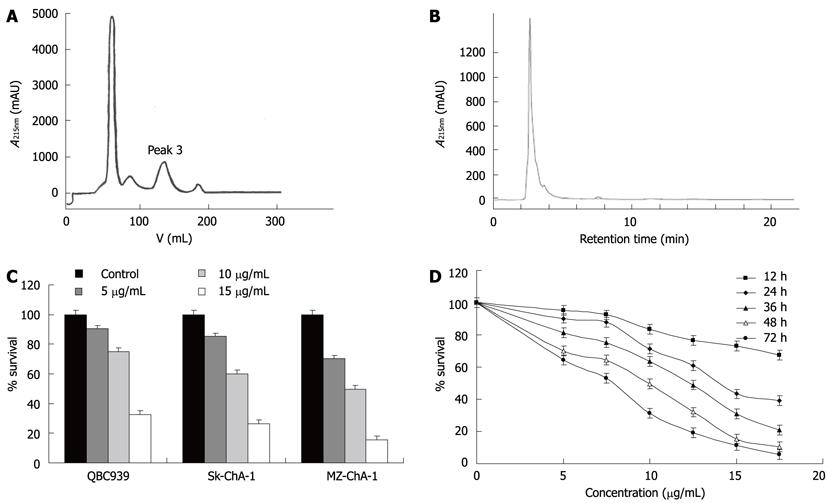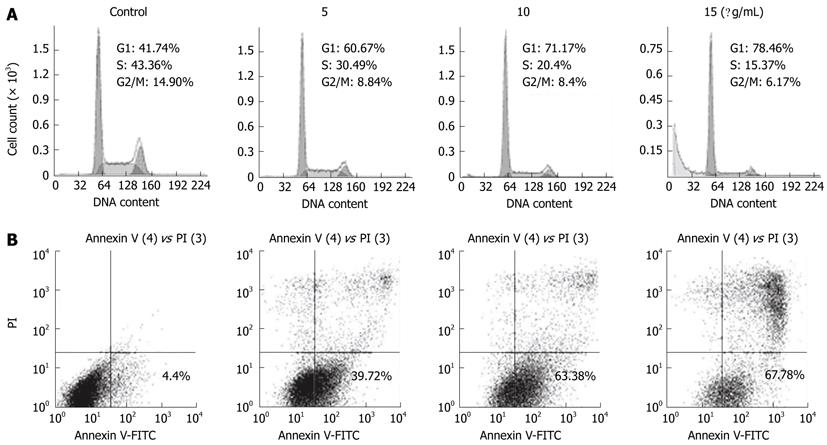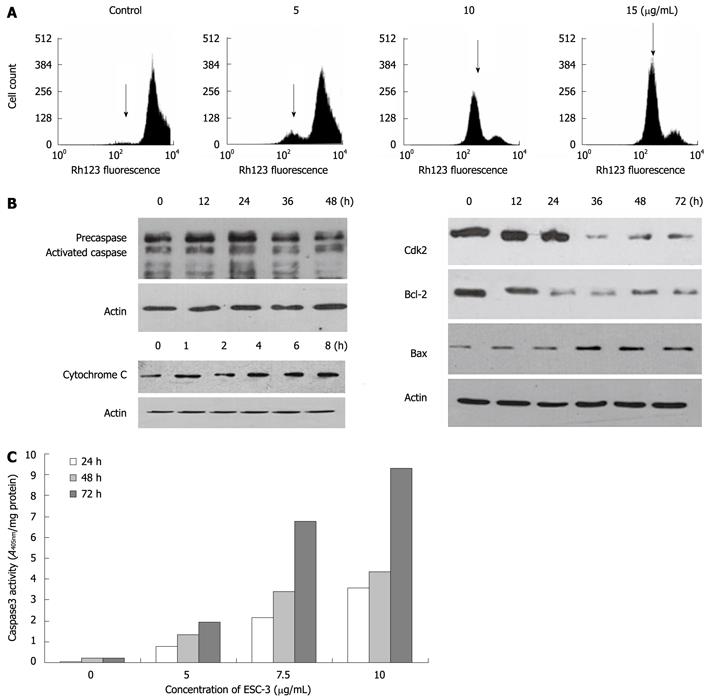Copyright
©2012 Baishideng Publishing Group Co.
World J Gastroenterol. Feb 21, 2012; 18(7): 704-711
Published online Feb 21, 2012. doi: 10.3748/wjg.v18.i7.704
Published online Feb 21, 2012. doi: 10.3748/wjg.v18.i7.704
Figure 1 Isolation of ESC-3 from the gallbladder of Crocodylus siamensis.
A: Using Sephadex LH-20; B: Using RP-18 reversed-phase columns; C: QBC939, Sk-ChA-1 and MZ-ChA-1 were treated continuously with different concentrations of ESC-3 for 48 h. Cell growth inhibition was analyzed by 3-(4,5-dimethylthiazol-2-yl)-2,5-diphenyl tetrazolium bromide (MTT) assay; D: Growth inhibitory effects of ESC-3 on Mz-ChA-1 cells. Exponentially growing Mz-ChA-1 cells were treated with different concentrations of ESC-3 for different periods of time. Cell growth inhibition was analyzed by the MTT assay.
Figure 2 Morphological changes in the Mz-ChA-1 cells after exposure to different concentrations (0 μg/mL and 10 μg/mL) of ESC-3 for 48 h.
A: Morphological changes visualized under an ordinary inverted phase-contrast microscope with Giemsa staining (magnification 400 ×); B: Morphological changes visualized under fluorescence microscope with AO/EB staining (magnification 200 ×); C: Morphological changes visualized under fluorescence microscope with Hoechst 33258 staining (magnification 400 ×). The arrows indicate the cells undergoing apoptosis. AO/EB: Acridine orange/ethidium bromide.
Figure 3 Effects of ESC-3 on cell cycle distribution and apoptosis.
A: Cell cycle analysis of Mz-ChA-1 cells using flow cytometry with propidium iodide (PI) staining and the DNA histograms; B: Assessment of apoptosis using flow cytometry with annexin v-fluorescein isothiocyanate (V-FITC)/PI staining and the dot-plot graph of Mz-ChA-1 cells.
Figure 4 Apoptosis induced by ESC-3 through the mitochondria-dependent pathway.
A: Effect of ESC-3 on the ΔΨm of cholangiocarcinoma cells. The increase in Rh123 hypofluorescence indicates a reduction in ΔΨm, which is shown with arrows; B: Expression of cytochrome C, caspase-3, CDK2, Bax, and Bcl-2 in Mz-ChA-1 cells treated with 10 μg/mL ESC-3 for different periods of time; C: Effect of ESC-3 on the activation of caspase-3 activity in Mz-ChA-1 cells. The cells were treated with 0 μg/mL, 5 μg/mL, 7.5 μg/mL and 12.5 μg/mL ESC-3, and caspase-3 activity was analyzed after 24 h, 48 h or 72 h.
-
Citation: Song W, Shen DY, Kang JH, Li SS, Zhan HW, Shi Y, Xiong YX, Liang G, Chen QX. Apoptosis of human cholangiocarcinoma cells induced by ESC-3 from
Crocodylus siamensis bile. World J Gastroenterol 2012; 18(7): 704-711 - URL: https://www.wjgnet.com/1007-9327/full/v18/i7/704.htm
- DOI: https://dx.doi.org/10.3748/wjg.v18.i7.704












